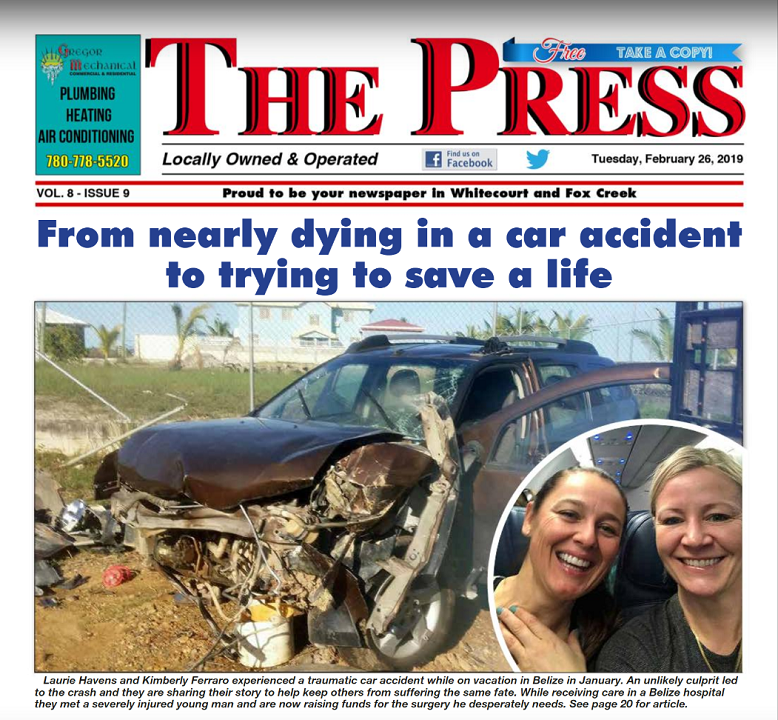B.C. Physical
Trauma Survivors Day, held annually on Oct. 17 each year, raises awareness of prevention, treatment and recovery from traumatic physical injuries.
As done in previous years,
Trauma Services BC is sharing stories of survivors with their reflections on how they are glad they prevented a more serious outcome by taking preventative actions. Their experiences help raise awareness, inspire compassion and give an opportunity for survivors to thank their care team(s).
PHSA Communications recently connected with Kimberly Ferraro, clinical nurse specialist at
Emergency Care BC, who told the story of a traumatic injury that she and a friend experienced on a holiday in 2019.
In January 2019, a friend and I had just landed in Belize for a vacation of a lifetime. After renting an SUV and loading it with our luggage, we began a long drive to Placencia.
After around two hours, I felt tired but I didn’t think anything of it after the long flight, however my friend could not keep her eyes open. I know that I was awake and alert driving and then I rolled the window up.
Then, the only thing I recall is the airbag hitting my face, and then nothing else as I went unconscious.
My friend recalled trees hitting the car but we left the road and went down an embankment – a distance of about 50 feet. The front of the vehicle was positioned on a rock ledge about four feet off the ground and the back had water halfway up the window. Apparently, carbon monoxide had leaked into our vehicle and we lost consciousness.
Within a few minutes, our doors were opened by locals who had witnessed the accident and they helped us out of the vehicle. With oxygen returning to the interior of the SUV, we regained consciousness. I could see the smoking airbag in front of me. I was extremely confused and had blood all over my face and could not understand why my arm would not work and I why I was in water.
I injured my humerus (arm), fractured in four different places. It needed a plate and eleven pins to hold it. I also fractured my coccyx. We both had a large hematoma on our backsides and internal bleeding, as we were very bruised in the abdominal/pelvis area. My friend fractured her sacrum, sternum, and six ribs.
We were both grateful to be alive.
We were taken by ambulance to a nearby hospital for basic care. With both of us working in health care at home as nurses, we knew that the care available would be very different than what we were used to in Canada. Staff did their very best under difficult circumstances.
After being treated at the local hospital, we were then transferred to a private hospital. However, within 36 hours of the crash, we were back on Canadian soil and surrounded by loved ones.

Kim and her friend were later featured in a
local newspaper article.
Luckily, we had put our suitcases in the back of the car; after the crash, they were now just behind our seats, which had been crushed. Had they hit any higher, they would’ve hit us in the back of the head.
I also suggest getting extra travel insurance. My insurance covered the injuries I sustained on the trip, but my girlfriend had to pay for the hospital visit, but was then reimbursed. Make sure you have a means to pay just in case something isn’t covered- she paid around $6,000 USD for one night in hospital and trauma services. She wouldn’t have received any care had she not had the ability to pay.
On a related note, when planning a trip to a different country, consider bringing along a portable carbon monoxide detector to use in rental vehicles or hotel rooms.
Check off the disclaimer box on a rental vehicle contract. If we didn’t checkmark the box for $22 a day, then we would have been accountable to pay the third party who owned the vehicle, as it was actually subleased to a major rental company.
I would also suggest accepting the medical assistance in getting home. We chose to drive ourselves to the airport and take a commercial flight home, and it was a PAINFUL couple of days to get back to Canada to one of our orthopedic surgeons! It probably was not the wisest but I was so grateful to see my own home emergency department and surgeon!
I’d like to thank the locals who helped us out. They found us within a short time, called for an ambulance and were trying to keep us calm.
They were very nice and helped us get safely up to the road, though I was carried up by my broken arm on a tarp! They kindly lined the embankment and put out their hands to help us up.

